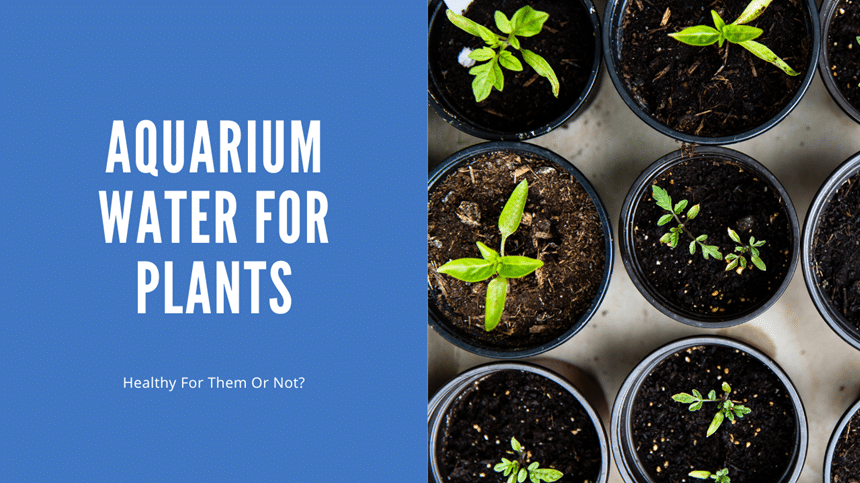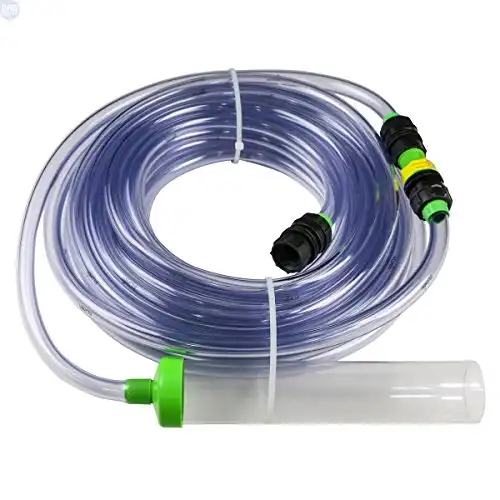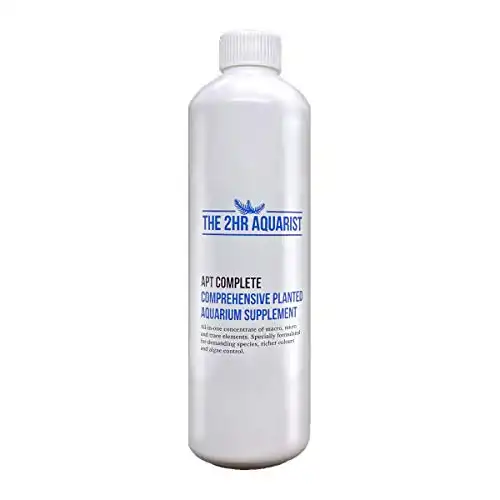Thank you for visiting! By the way… any links on this page that lead to products on Amazon and other stores/partners are affiliate links Aquarium Store Depot earns a commission if you make a purchase.
Do you love aquariums and gardening? These two hobbies go hand in hand probably more than you realize. In fact, aquarium water is one of the best natural fertilizers for houseplants and outdoor plants due to its nutrient content. Before you put your water change waste down the drain, consider watering your plants at the same time!
Keep reading to find out all the benefits of using aquarium water for plants and how to set up a watering schedule!
Key Takeaways
- Aquarium water is rich in macro and micronutrients, like nitrogen and phosphorus, that are commonly found in popular fertilizer options.
- The parameters of your tank water may be influenced by tap water, food ingredients, and fish output.
- Chemically treated water should not be used on edible plants.
- Aquaponics is a large field in agriculture and encourages growing plants in a fish-based system.
Why It Works
Before we can see how fish tank water can be used to feed terrestrial plants, we need to understand what makes this water special. Like anything in the aquarium hobby, it all ties back to the nitrogen cycle.
When you cycled your tank, you needed to introduce a source of ammonia into your aquarium. This could have been done organically or chemically. After a while, beneficial bacteria started to reproduce and process the ammonia into other compounds, like nitrite and nitrate. Once enough bacteria had populated the aquarium, ammonia and nitrite could be maintained at 0 ppm while nitrate was controlled through water changes.
Just because ammonia and nitrite aren’t readable in your current tank through test kits doesn’t mean that they’re not present though. In fact, fish are constantly creating ammonia through respiration and waste. Most test kits don’t read to this precision.
Plants and Nutrients

If you have a freshwater aquarium, you may have been recommended to add live plants to help cycle the aquarium and to keep an overall healthy system. There is a good reason for this! As we’ll see, aquatic plants are very similar to terrestrial plants in how they rely on nutrients; aquarium plants get most of their nutrients through the water column, though sometimes through the substrate, and most terrestrial plants rely on the soil to receive nutrients.
Plants can absorb all of these nitrogen compounds: ammonium, ammonia, nitrite, and nitrate. Most species uptake nitrate the most, but live plants can help maintain the other levels. This is why adding live plants to an aquarium can decrease the toxicity of the water and maintain levels in the future.
It’s important to note that freshwater aquariums also contain other important compounds, like magnesium and phosphate, that aren’t regularly tested for. Just because hobbyists don’t monitor these parameters doesn’t mean they’re not present in the aquarium. As we’ll see, they’re some of the most important compounds for growing terrestrial plants!
How can our fish tanks help our indoor plants and possibly even help grow the food that we eat?
Plant Fertilizer
The next time you go into an outdoor store or gardening center, take a look at the available fertilizers. You may see a variety of powder and liquid options, each of which will provide a percent breakdown of the nutrients offered.

You will likely see a ratio of three values on the front, which read N-P-K1, or nitrogen-phosphorus-potassium. These are some of the most important nutrients for plant growth, and the ratio needed will depend on the species of plant being grown.
While you likely won’t get this precise ratio with fish tank water, nitrogen, phosphorus, and potassium are present in your aquarium. While nitrogen is predictable, phosphorus, potassium, and micronutrient levels will vary as they are influenced by tap water, food ingredients, and other inputs.
Now that we know how aquarium water acts as a fertilizer, how can we use what we have?
Watering and Water Changes
The best way to use your aquarium water as a plant fertilizer is by not wasting what you already have! More than likely, you perform water changes on your aquarium anywhere from once a week to several times a month. Chances are that you’ve been throwing that old water down the drain.
Before you get rid of that water, get a watering can! Use an aquarium siphon or cup to remove the water from the tank and into your container. As long as there isn’t a ton of fish waste or other organic debris, this water can be directly used to water plants. It really is as easy as that!
The Python is a mainstay in the fish hobby. Easily clean your aquarium by connecting this to your sink!
If you’re siphoning your substrate during your water change, then you may want to take some time to let that gunk settle at the bottom of your container. While it is unlikely to hurt your plants, fish waste left sitting on top of the soil can attract other garden pests and lead to a nasty smell.
But wait! Don’t throw that fish poop out either. In fact, this organic matter can be directly added to a compost pile along with any excess water.
Storing Water
Unless you have a ton of plants, you’ll probably end up with leftover water from your fish tank. This water can be discarded as usual, or you may consider setting up a reserve for later use.
This reserve is like setting up another fish tank but in a closed tub or bucket. Here is one way of setting up an aquarium water reserve:
Use a bucket, tub, or other large container. This container should not let light in as this will facilitate algae growth that will end up stealing nutrients. In the worst-case scenario, this nutrient-packed algae can be used for composting!
This container should also be closed so that no contaminants, like aerosols, insects, or a thirsty pet, can make their way in. If you use a trash cute, the Brute brand is a great mainstay in the hobby. Make sure it is labeled as food grade.
Use filter media. Contrary to popular belief, beneficial bacteria do not live in the water column. Instead, they live on the surfaces in our fish tanks, mainly in porous filter media. While new amounts of ammonia or nitrite are unlikely to enter your container, beneficial bacteria will continue to make your used fish tank water a healthy environment. You can also squeeze out your sponges during water changes to release some of the bacteria and the nutrients.
Install a pump. Even though this water will be processed by beneficial bacteria, stagnant water will still invite unhealthy microbes. Stagnant water will likely grow algae and other slime while also depleting the water of oxygen. This could create anaerobic conditions, which would not be healthy for ornamental plants.
Check your water regularly. Fish tank water won’t store indefinitely, and we don’t recommend hanging onto it for more than a week, especially if there is sediment or other organics present. If you notice a funky smell or any other signs of contamination, dispose of the water.
Indoor Plants In Your Aquarium
Aquarium water can be used to water plants with a watering can, but it can also be used straight from the source. Many hobbyists have begun growing indoor plants, and even some fruits and vegetables, straight out of their aquariums. This removes the need to store water and gives plants direct access to some of the best plant fertilizers available. In return, the plant helps remove excess nutrients from the water column.
In order to grow terrestrial plants out of your aquarium, you will need an additional grow light. Also, some plants cannot have constantly submerged roots, so some special selection is needed.
Considerations When Using Aquarium Water For Plants
Aquariums make some of the best plant fertilizers available, but you might have a few questions about keeping healthy fish and healthy plants.
Should you add more nutrients directly into your aquarium?
It would make sense that adding more nitrogen compounds and other nutrients to your aquarium would make your fertilizer even better, but aquariums have a delicate balance of parameters. Too much ammonia or nitrite can lead to poisoning your fish; even high levels of nitrates can eventually impact your aquarium.
However, many hobbyists add nitrogen additives to their aquariums to help their aquatic plants grow. In moderation, this is a great way to facilitate growth and even get more desirable colors out of your live plants. In terms of dosing other macro and micronutrients, like magnesium and phosphate, it’s generally not necessary unless you are certain your aquarium is lacking in them.
Editor's Choice
Made by an aquascaper for aquascapers. This is the best all around aquarium plant fertilizer on the market. Marco and micronutrients in one bottle!
Use Coupon Code ASDComplete for 10% off your order!
Being able to water plants with fish tank water is an added benefit of your aquarium, not its main purpose (though we’ll discuss more in the aquaponics section later).
Should you be worried about aquarium chemicals?
Yes, there are some potential hazards associated with using fish tank water that has been treated with chemical products. This is especially a concern if using the water on edible plants.
Most hobbyists dose their fish tanks with at least one chemical. Most often, this is a dechlorinator that removes chlorine and chloramine to make water safe for fish, but can also include medications. However, most of these chemicals are not food-grade and cannot be ingested safely for certain. Some fish keepers use alternatives, like ascorbic acid, as a dechlorinator, but this takes some special measuring.
One product you might not consider a threat to plants is aquarium salt. Most plants cannot physiologically process salt and may start to die as a result. You should never use saltwater for a garden if you keep a marine tank.
If the tank has been medicated in the past is is currently being medicated, you should also not use the water on your garden.
In general, you should avoid using chemically treated fish tank water on plants you intend to eat.
Does pH matter?
So far, we have not discussed pH. Freshwater aquariums typically have a neutral pH of around 7.0, but some blackwater or cichlid tanks might have well above or below that. Most plants thrive in the neutral zone, though some species prefer acidic or basic conditions respectively.
Another important parameter to consider is alkalinity, or the ability of water to buffer changes in pH. This parameter is rarely discussed in freshwater aquariums, with general hardness being a bigger concern. However, a high alkalinity can also impede plant growth and start to affect the effectiveness of pesticides and other enhancers.
Aquaponics
If you’re serious about using your fish tank’s water to facilitate your plant growth, you might be interested in the greater field of aquaponics.
This takes growing plants with fish tank water to a whole other level. Simply put, aquaponics is sustainable farming using a closed-loop system that is dependent on the nitrogen cycle: fish create waste and the plants uptake the nutrients. Plants are grown directly in the water for easy nutrient uptake without the need for soil.
Some plants that can be grown in these systems include lettuce, tomatoes, peppers, and herbs.
Can I use fish tank water to water my plants?
Yes! Freshwater fish tank water is a great source of nutrients required for healthy plant growth, like nitrates. However, too much watering with aquarium water can overload your plants with nutrients, which can also be detrimental.
Is aquarium water conditioner good for plants?
If you’re planning on eating the foods you’re growing, you should not use chemically treated fish tank water. This is because these chemicals have not been evaluated for consumption. Instead, alternatives, like ascorbic acid, could be used to neutralize chlorine for fish.
Is fish tank water good for gardens?
Yes, you can use fish tank water on indoor and outdoor plants. Make sure to avoid plants that you will eat as aquarium water is often treated with various chemicals, like dechlorinator.
Conclusion
If you love aquariums and gardening, then there are many reasons to start using your tank water to feed your plants! Aquarium water is packed with important nutrients, like nitrate, that can fertilize your plants as needed. Avoid using water that has been chemically treated on edible plants, but save your water change leftovers for later use.
- About the Author
- Latest Posts
I’m thrilled that you found Aquarium Store Depot! Here you’ll find information on fish, aquariums, and all things aquatics related. I’m a hobbyist (being doing this since I was 11) and here to help other hobbyists thrive with their aquariums! I adhere to a high quality Editorial Process and Review products with real life field usage and practical analysis.







